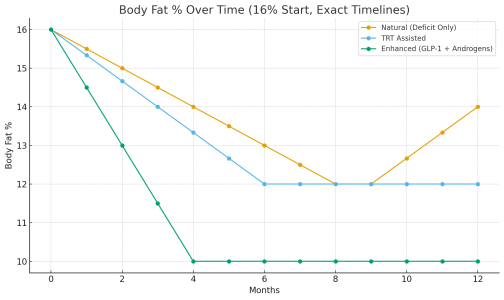- Joined
- Sep 16, 2025
- Messages
- 1,276
- Reaction score
- 2,001
- Points
- 173
Abstract
For years, dedicated looksmaxxing communities have understood that achieving and maintaining a lean physique is the bare minimum requirement for improving overall appearance and avoiding being perceived as unattractive. This study compiles and analyzes self-experimentation results from three participants (the authors and two collaborators) over a one-year period to evaluate different methods of achieving leanness, their ease of implementation, speed, comfort, and short-term safety. The three approaches included: a natural caloric deficit with no pharmaceutical support, testosterone replacement therapy (TRT), and a combination of supraphysiological androgen use with GLP-1/GIP receptor agonist therapy (tirzepatide). Our findings provide a comparative assessment of these strategies, highlighting both the practical and subjective experiences of each participant.
Methods
Three male participants, all aged approximately 20, engaged in distinct fat loss protocols over a one-year observation period:
Body fat percentages were estimated via caliper measurements and visual assessment, while weight, strength, and subjective comfort levels were tracked weekly. Blood work was conducted periodically to monitor basic health markers. No long-term follow-up was performed.
Results

Discussion
The data indicates that pharmacological interventions can dramatically improve both the speed and comfort of fat loss. The participant using tirzepatide and high-dose androgens reported a significantly easier experience, faster results, and concurrent muscle growth, in contrast to the natural participant, who struggled to sustain leanness. The TRT-assisted approach fell between these extremes, with improved muscle preservation but less comfort than the enhanced protocol.
Conclusions
Based on these observations, the authors recommend a combination of GLP-1/GIP receptor agonists (e.g., tirzepatide) to manage appetite and caloric intake, alongside supraphysiological androgen use to preserve or increase muscle mass during a caloric deficit. In this small self-study, these interventions were the fastest and most comfortable route to achieving and maintaining low body fat without any significant short-term health issues.
Limitations
Conflicts of Interest
The authors report no conflicts of interest. This project was conducted purely out of personal interest in optimizing physique and performance outcomes.
For years, dedicated looksmaxxing communities have understood that achieving and maintaining a lean physique is the bare minimum requirement for improving overall appearance and avoiding being perceived as unattractive. This study compiles and analyzes self-experimentation results from three participants (the authors and two collaborators) over a one-year period to evaluate different methods of achieving leanness, their ease of implementation, speed, comfort, and short-term safety. The three approaches included: a natural caloric deficit with no pharmaceutical support, testosterone replacement therapy (TRT), and a combination of supraphysiological androgen use with GLP-1/GIP receptor agonist therapy (tirzepatide). Our findings provide a comparative assessment of these strategies, highlighting both the practical and subjective experiences of each participant.
Methods
Three male participants, all aged approximately 20, engaged in distinct fat loss protocols over a one-year observation period:
- Natural Protocol: One participant followed a standard caloric deficit without pharmaceutical assistance. The target was to achieve 12% body fat through dietary restriction and training.
- TRT Protocol: The second participant underwent testosterone replacement therapy (TRT) while cutting aggressively to 12% body fat, with close monitoring of muscle retention and overall well-being.
- Enhanced Protocol: The lead author used supraphysiological doses of androgens combined with tirzepatide, a GLP-1/GIP receptor agonist. The goal was to achieve single-digit body fat levels while gaining muscle mass and maintaining comfort.
Body fat percentages were estimated via caliper measurements and visual assessment, while weight, strength, and subjective comfort levels were tracked weekly. Blood work was conducted periodically to monitor basic health markers. No long-term follow-up was performed.
Results
- Natural Protocol:
- Time to 12% body fat: ~8 months.
- Subjective experience: Reported as difficult and mentally exhausting; hunger and lethargy persisted throughout.
- Outcome: Participant rebounded to ~14% body fat within two months post-cut, citing lack of willpower and sustainability.
- Notes: No noticeable negative health markers during cutting phase.
- TRT Protocol:
- Time to 12% body fat: ~6 months.
- Subjective experience: Challenging but manageable; muscle mass maintained successfully.
- Outcome: Participant successfully maintained leanness beyond the cut.
- Notes: Health markers remained stable; no significant adverse effects observed.
- Enhanced Protocol:
- Time to 10% body fat: ~4 months.
- Subjective experience: Extremely comfortable; hunger suppressed by tirzepatide, and androgen use facilitated strength and muscle gain during the deficit.
- Outcome: Achieved sub-10% body fat with improved muscle density and minimal discomfort.
- Notes: No concerning short-term health markers observed.

Discussion
The data indicates that pharmacological interventions can dramatically improve both the speed and comfort of fat loss. The participant using tirzepatide and high-dose androgens reported a significantly easier experience, faster results, and concurrent muscle growth, in contrast to the natural participant, who struggled to sustain leanness. The TRT-assisted approach fell between these extremes, with improved muscle preservation but less comfort than the enhanced protocol.
Conclusions
Based on these observations, the authors recommend a combination of GLP-1/GIP receptor agonists (e.g., tirzepatide) to manage appetite and caloric intake, alongside supraphysiological androgen use to preserve or increase muscle mass during a caloric deficit. In this small self-study, these interventions were the fastest and most comfortable route to achieving and maintaining low body fat without any significant short-term health issues.
Limitations
- Small sample size (n=3).
- Self-reported measures and subjective comfort ratings introduce bias.
- Lack of standardized body composition testing.
- No long-term follow-up on health markers or side effects.
- Results may not generalize to a broader population.
Conflicts of Interest
The authors report no conflicts of interest. This project was conducted purely out of personal interest in optimizing physique and performance outcomes.